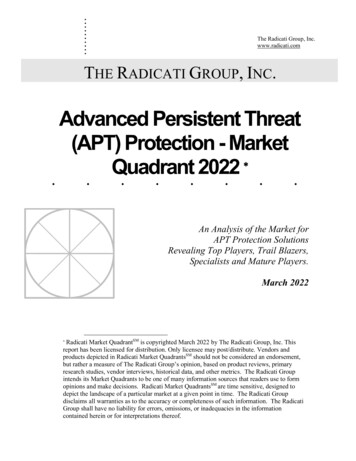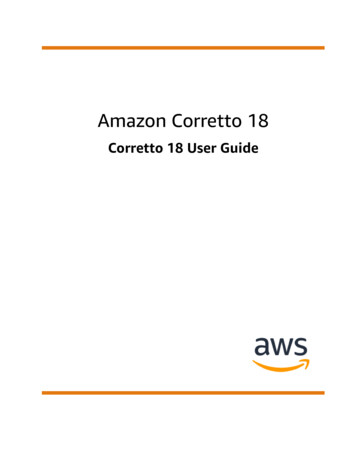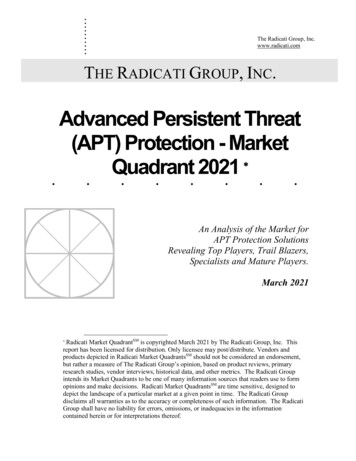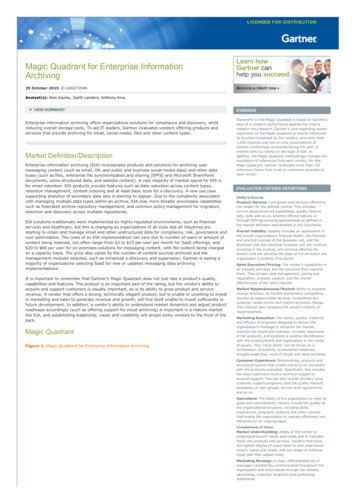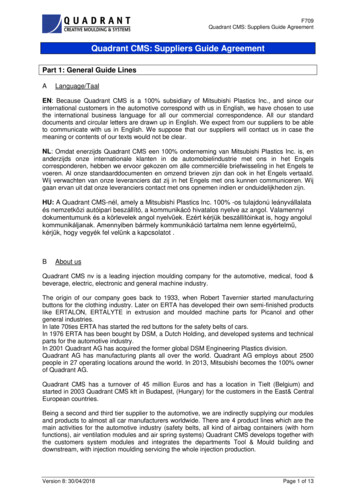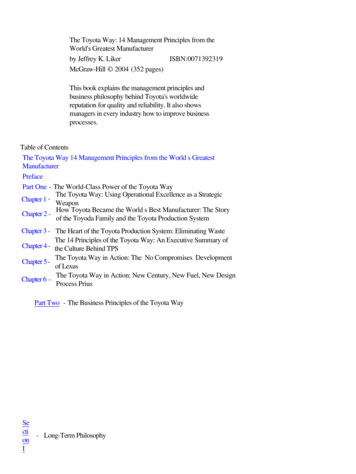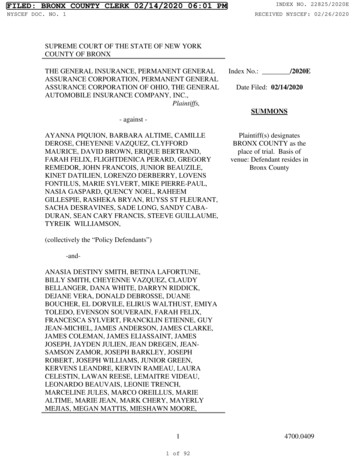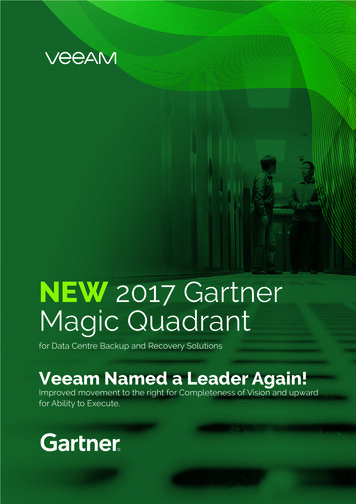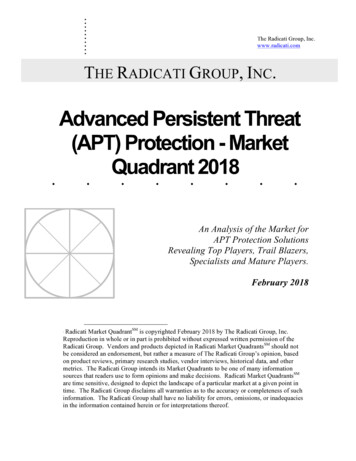
Transcription
.The Radicati Group, Inc.www.radicati.comTHE RADICATI GROUP, INC.Advanced Persistent Threat(APT) Protection - MarketQuadrant 2018 .An Analysis of the Market forAPT Protection SolutionsRevealing Top Players, Trail Blazers,Specialists and Mature Players.February 2018Radicati Market QuadrantSM is copyrighted February 2018 by The Radicati Group, Inc.Reproduction in whole or in part is prohibited without expressed written permission of theRadicati Group. Vendors and products depicted in Radicati Market QuadrantsSM should notbe considered an endorsement, but rather a measure of The Radicati Group’s opinion, basedon product reviews, primary research studies, vendor interviews, historical data, and othermetrics. The Radicati Group intends its Market Quadrants to be one of many informationsources that readers use to form opinions and make decisions. Radicati Market QuadrantsSMare time sensitive, designed to depict the landscape of a particular market at a given point intime. The Radicati Group disclaims all warranties as to the accuracy or completeness of suchinformation. The Radicati Group shall have no liability for errors, omissions, or inadequaciesin the information contained herein or for interpretations thereof.
APT Protection - Market Quadrant 2018TABLE OF CONTENTSRADICATI MARKET QUADRANTS EXPLAINED . 2MARKET SEGMENTATION – ADVANCED PERSISTENT THREAT (APT) PROTECTION . 4EVALUATION CRITERIA . 6MARKET QUADRANT – APT PROTECTION . 9KEY MARKET QUADRANT HIGHLIGHTS . 10APT PROTECTION - VENDOR ANALYSIS. 10TOP PLAYERS . 10TRAIL BLAZERS . 24SPECIALISTS . 30 Please note that this report comes with a 1-5 user license. If you wish to distribute the report tomore than 5 individuals, you will need to purchase an internal site license for an additional fee.Please contact us at admin@radicati.com if you wish to purchase a site license.Companies are never permitted to post reports on their external web sites or distribute by othermeans outside of their organization without explicit written prior consent from The RadicatiGroup, Inc. If you post this report on your external website or release it to anyone outside of yourcompany without permission, you and your company will be liable for damages. Please contactus with any questions about our policies. Copyright February 2018, The Radicati Group, Inc. Reproduction Prohibited1
APT Protection - Market Quadrant 2018RADICATI MARKET QUADRANTS EXPLAINEDRadicati Market Quadrants are designed to illustrate how individual vendors fit within specifictechnology markets at any given point in time. All Radicati Market Quadrants are composed offour sections, as shown in the example quadrant (Figure 1).1. Top Players – These are the current market leaders with products that offer, bothbreadth and depth of functionality, as well as posses a solid vision for the future. TopPlayers shape the market with their technology and strategic vision. Vendors don’tbecome Top Players overnight. Most of the companies in this quadrant were firstSpecialists or Trail Blazers (some were both). As companies reach this stage, they mustfight complacency and continue to innovate.2. Trail Blazers – These vendors offer advanced, best of breed technology, in some areas oftheir solutions, but don’t necessarily have all the features and functionality that wouldposition them as Top Players. Trail Blazers, however, have the potential for “disrupting”the market with new technology or new delivery models. In time, these vendors are mostlikely to grow into Top Players.3. Specialists – This group is made up of two types of companies:a. Emerging players that are new to the industry and still have to develop someaspects of their solutions. These companies are still developing their strategy andtechnology.b. Established vendors that offer very good solutions for their customer base, andhave a loyal customer base that is totally satisfied with the functionality they aredeploying.4. Mature Players – These vendors are large, established vendors that may offer strongfeatures and functionality, but have slowed down innovation and are no longerconsidered “movers and shakers” in this market as they once were.a. In some cases, this is by design. If a vendor has made a strategic decision to movein a new direction, they may choose to slow development on existing products.Copyright February 2018, The Radicati Group, Inc. Reproduction Prohibited2
APT Protection - Market Quadrant 2018b. In other cases, a vendor may simply have become complacent and be outdeveloped by hungrier, more innovative Trail Blazers or Top Players.c. Companies in this stage will either find new life, reviving their R&D efforts andmove back into the Top Players segment, or else they slowly fade away as legacytechnology.Figure 1, below, shows a sample Radicati Market Quadrant. As a vendor continues to develop itsproduct solutions adding features and functionality, it will move vertically along the “y”functionality axis.The horizontal “x” strategic vision axis reflects a vendor’s understanding of the market and theirstrategic direction plans. It is common for vendors to move in the quadrant, as their productsevolve and market needs change.HighRadicati Market QuadrantSMMature PlayersTop Players Company LFunctionality Company Z Company Y Company J Company HLow Company D Company BCompany CCompany ASpecialistsLow Company FCompany G Company ETrail BlazersStrategic VisionHighFigure 1: Sample Radicati Market QuadrantCopyright February 2018, The Radicati Group, Inc. Reproduction Prohibited3
APT Protection - Market Quadrant 2018MARKET SEGMENTATION – ADVANCED PERSISTENT THREAT (APT) PROTECTIONThis edition of Radicati Market QuadrantsSM covers the “Advanced Persistent Threat (APT)Protection” segment of the Security Market, which is defined as follows: Advanced Persistent Threat Protection – are a set of integrated solutions for thedetection, prevention and possible remediation of zero-day threats and persistentmalicious attacks. APT solutions may include but are not limited to: sandboxing,reputation networks, threat intelligence management and reporting, forensic analysis andmore. Some of the leading players in this market are Barracuda Networks, Cisco,FireEye, Forcepoint, Fortinet, Kaspersky Lab, McAfee, Microsoft, Palo Alto Networks,Sophos, Symantec, and Webroot. This report only looks at vendor APT protection solutions aimed at the needs of enterprisebusinesses. It does not include solutions that target primarily service providers (i.e. carriers,ISPs, etc.). APT protection solutions can be deployed in multiple form factors, including software,appliances (physical or virtual), private or public cloud, and hybrid models. Virtualizationand hybrid solutions are increasingly available through most APT security vendors. APT solutions are seeing rapid adoption across organization of all business sizes and industrysegments, as all organizations are increasingly concerned about zero-day threats and highlytargeted malicious attacks. The worldwide revenue for APT Protection solutions is expected to grow from over 3.7billion in 2018, to over 8.6 billion by 2022.Copyright February 2018, The Radicati Group, Inc. Reproduction Prohibited4
APT Protection - Market Quadrant 2018APT Protection - Revenue Forecast, 2018-2022 10,000 8,600 9,000 8,000 6,880 7,000 5,549 6,000 5,000 3,790 4,548 4,000 3,000 2,000 1,000 020182019202020212022Figure 2: APT Protection Market Revenue Forecast, 2018 – 2022Copyright February 2018, The Radicati Group, Inc. Reproduction Prohibited5
APT Protection - Market Quadrant 2018EVALUATION CRITERIAVendors are positioned in the quadrant according to two criteria: Functionality and StrategicVision.Functionality is assessed based on the breadth and depth of features of each vendor’s solution.All features and functionality do not necessarily have to be the vendor’s own originaltechnology, but they should be integrated and available for deployment when the solution ispurchased.Strategic Vision refers to the vendor’s strategic direction, which comprises: a thoroughunderstanding of customer needs, ability to deliver through attractive pricing and channelmodels, solid customer support, and strong on-going innovation.Vendors in the APT Protection space are evaluated according to the following key features andcapabilities: Deployment Options – availability of the solution in different form factors, such as onpremises solutions, cloud-based services, hybrid, appliances and/or virtual appliances. Platform Support – support for threat protection across a variety of platforms including:Windows, macOS, Linux, iOS, and Android. Malware detection – usually based on behavior analysis, reputation filtering, advancedheuristics, and more. Firewall & URL – filtering for attack behavior analysis. Web and Email Security – serve to block malware that originates from Web browsing oremails with malicious intent. SSL scanning – traffic over an SSL connection is also commonly monitored to enforcecorporate policies. Encrypted traffic analysis – provides monitoring of behavior of encrypted traffic to detectpotential attacks.Copyright February 2018, The Radicati Group, Inc. Reproduction Prohibited6
APT Protection - Market Quadrant 2018 Forensics and Analysis of zero-day and advanced threats – provide heuristics and behavioranalysis to detect advanced and zero-day attacks. Sandboxing and Quarantining – offer detection and isolation of potential threats. Endpoint Detection and Response (EDR) – is the ability to continuously monitor endpointsand network events, in order to detect internal or external attacks and enable rapid response.EDR systems feed information into a centralized database where it can be further analyzedand combined with advanced threat intelligence feeds for a full understanding of emergingthreats. Some EDR systems also integrate with sandboxing technologies for real-time threatemulation. Most EDR systems integrate with forensic solutions for deeper attack analysis. Directory Integration – integration with Active Directory or LDAP, to help manage andenforce user policies. Cloud Access Security Broker (CASB) – are on-premises or cloud-based solutions that sitbetween users and cloud applications to monitor all cloud activity and enforce securitypolicies. CASB solutions can monitor user activity, enforce security policies and detecthazardous behavior, thus extending an organization’s security policies to cloud services. Data Loss Prevention (DLP) – allows organizations to define policies to prevent loss ofsensitive electronic information. Mobile Device Protection – the inclusion of Mobile Device Management (MDM) orEnterprise Mobility Management (EMM) features to help protect mobile endpoints. Administration – easy, single pane of glass management across all users and networkresources. Real-time updates – to rapidly block, quarantine and defend against newly identified threatsor attacks across all network resources. Remediation – refers to the ability to automatically restore endpoints, servers and otherdevices to a healthy state, in the event they have been compromised. Remediation mayinvolve re-imaging and/or other cleanup processes and techniques.Copyright February 2018, The Radicati Group, Inc. Reproduction Prohibited7
APT Protection - Market Quadrant 2018 Environment threat analysis – to detect existing threat exposure and potential security gaps.In addition, for all vendors we consider the following aspects: Pricing – what is the pricing model for their solution, is it easy to understand and allowscustomers to budget properly for the solution, as well as is it in line with the level offunctionality being offered, and does it represent a “good value”. Customer Support – is customer support adequate and in line with customer needs andresponse requirements. Professional Services – does the vendor provide the right level of professional services forplanning, design and deployment, either through their own internal teams, or throughpartners.Note: On occasion, we may place a vendor in the Top Player or Trail Blazer category even ifthey are missing one or more features listed above, if we feel that some other aspect(s) of theirsolution is particularly unique and innovative.Copyright February 2018, The Radicati Group, Inc. Reproduction Prohibited8
APT Protection - Market Quadrant 2018MARKET QUADRANT – APT PROTECTIONRadicati Market QuadrantSMHighMature PlayersTop PlayersSymantec Forcepoint McAfee FunctionalitySophos Fortinet Kaspersky Lab Webroot FireEye Barracuda Microsoft Palo Alto Networks Cisco Low SpecialistsLowTrail BlazersStrategic VisionFigure 3: APT Protection Market Quadrant, 2018High Radicati Market QuadrantSM is copyrighted February 2018 by The Radicati Group, Inc.Reproduction in whole or in part is prohibited without expressed written permission of the RadicatiGroup. Vendors and products depicted in Radicati Market QuadrantsSM should not be considered anendorsement, but rather a measure of The Radicati Group’s opinion, based on product reviews,primary research studies, vendor interviews, historical data, and other metrics. The Radicati Groupintends its Market Quadrants to be one of many information sources that readers use to form opinionsand make decisions. Radicati Market QuadrantsSM are time sensitive, designed to depict thelandscape of a particular market at a given point in time. The Radicati Group disclaims all warrantiesas to the accuracy or completeness of such information. The Radicati Group shall have no liabilityfor errors, omissions, or inadequacies in the information contained herein or for interpretationsthereof. Copyright February 2018, The Radicati Group, Inc. Reproduction Prohibited9
APT Protection - Market Quadrant 2018KEY MARKET QUADRANT HIGHLIGHTS The Top Players in the market are Symantec, Forcepoint, McAfee, and Sophos. The Trail Blazers quadrant includes Kaspersky Lab, and Webroot. The Specialists quadrant includes Fortinet, FireEye, Barracuda Networks, Cisco, Microsoft,and Palo Alto Networks. There are no Mature Players in this market at this time.APT PROTECTION - VENDOR ANALYSISTOP PLAYERSSYMANTEC350 Ellis StreetMountain View, CA 94043www.symantec.comFounded in 1982, Symantec has grown to be one of the largest providers of enterprise securitytechnology. In 2016, Symantec completed its acquisition of Blue Coat, a leading provider of websecurity technology. Symantec’s security solutions are powered by its Global Intelligence Networkwhich combines technologies from both Symantec and Blue Coat, to offer real-time threatintelligence. Symantec is a publicly traded company.SOLUTIONSSymantec provides on-premises, hybrid and cloud-based solutions for advanced threat protection tosafeguard against advanced persistent threats and targeted attacks, detect both known and unknownmalware, and automate the containment and resolution of incidents. Symantec’s security portfoliocomprises the following components:Copyright February 2018, The Radicati Group, Inc. Reproduction Prohibited10
APT Protection - Market Quadrant 2018 Symantec Advanced Threat Protection (ATP) – is a unified platform that uncovers, prioritizes,investigates, and remediates advanced threats across multiple control points from a singleconsole. It aggregates and correlates threat events from the three ATP modules: Endpoint, Email,and Network. Symantec ATP is a hybrid solution that consists of an on-premises appliance (orvirtual appliance) that uses cloud services for sandboxing and correlation. The solution platformprovides a single pane of glass across all three modules, providing visibility into attacks in realtime and the ability to quickly remediate attacks across multiple threat vectors.o Symantec ATP: Endpoint module – provides Endpoint Detection and Response (EDR)capabilities without adding a new endpoint agent. It leverages the Symantec EndpointProtection product, to look for Indicators-of-Compromise (IoC) across all endpoints;remediate all instances of threats, isolate compromised endpoints and blacklist malicious files,with a single click. ATP: Endpoint 3.0 has added full endpoint activity recording, directsearching of endpoints for indicators of compromise, file-less threat detections (includingsuspicious PowerShell scripts and memory exploits) and hybrid sandboxing (cloud-based andon-premises).o Symantec ATP: Network module – provides automated threat prevention and detection at thenetwork layer by examining both inbound and outbound traffic. It uncovers stealthy threatswith multiple technologies, including: file reputation analysis, IPS, and a cloud-hostedsandbox and detonation capability. Organizations can search for IoCs across their network,and blacklist files or URLs once they are identified as malicious. Symantec recently addedintegration with Malware Analysis to ATP: Network.o Symantec ATP: Email module – protects against email-borne targeted attacks and advancedthreats, such as spear-phishing. It leverages a cloud-based sandbox and detonation capabilityand Symantec Email Security.cloud to expose threat data from malicious emails. It inspectsURLs embedded in email twice: once when the email passes through the services, and againwhen the user clicks on the links. It can also export indicators of compromise from theinspected email and integrate with third-party SIEM solutions.o Symantec Endpoint Detection and Response (EDR) Cloud – delivers in-depth threatvisibility and breach response across the entire enterprise. It offers multiple layers ofdetection, visual analysis of complex cyber data and automated playbooks to easeadministration. In addition, Symantec’s EDR cloud solution provides full visibility andautomated threat hunting across all endpoints through applied forensic reasoning andCopyright February 2018, The Radicati Group, Inc. Reproduction Prohibited11
APT Protection - Market Quadrant 2018expertise to identify suspicious activity. Organizations can conduct a point-in-time scanof the entire environment to automatically hunt and remediate suspicious activity in theenterprise. The solution does not require the deployment of new endpoint agents. Symantec ProxySG appliance, Secure Web Gateway Virtual Appliance, or Cloud Service –these solutions serve to block known threats, malicious sources, unknown categories, andmalware delivery networks at the gateway in real-time. Symantec Content Analysis integrateswith the ProxySG appliance to orchestrate malware scanning and application blacklisting, whileSymantec SSL Visibility provides additional visibility into threats hidden in encrypted trafficacross all Symantec components, as well as third-party tools. Symantec Content Analysis – analyzes and mitigates unknown content by automaticallyinspecting files from ProxySG, Symantec Messaging Gateway, or other sources though multiplelayers of in-house proprietary technology as well as third-party technology (reputation, dual antimalware engines, static code analysis, etc.). It then brokers suspicious content to the SymantecMalware Analysis solution or other third parties for sandboxing. Content Analysis inspection andsandboxing are available as on-premises, hybrid or cloud-hosted solutions. Intelligence is sharedthrough the Symantec Global Intelligence Network, providing enhanced protection across theentire security infrastructure. Symantec Security Analytics – utilizes high-speed full-packet capture, indexing, deep packetinspection (DPI) and anomaly detection to enable incident response and eradicate threats that mayhave penetrated the network, even in Industrial Control or SCADA environments. Intelligence onthreats is used to investigate and remediate the full scope of the attack, including other instancesof malicious files already residing in the environment. Integrations with EDR solutions, includingSymantec ATP: Endpoint provide network to endpoint visibility and response. Intelligence isshared across the Symantec Global Intelligence Network to automate detection and protectionagainst newly identified threats, for all Symantec customers. Symantec Global Intelligence Network (GIN) – provides a centralized, cloud-based, threatindicator repository and analysis platform. It enables the discovery, analysis, and granularclassification of threats from multiple vectors (e.g. endpoint, network, web, email, application,IoT, and others) and proactively protects other vectors of ingress without the need to re-evaluatethe threat. GIN distributes critical threat indicators derived from a combination of human and AI(artificial intelligence) research processes, including file hashes, URLs, IP addresses, andapplication fingerprints. GIN technology can be rapidly deployed into virtually any product orCopyright February 2018, The Radicati Group, Inc. Reproduction Prohibited12
APT Protection - Market Quadrant 2018service, including cloud applications, IoT to server class hardware (x86 and ARM), Windows,iOS, Linux, and MacOS.STRENGTHS Symantec offers on-premises, cloud, and hybrid options across most of its security productportfolio. Symantec's endpoint protection and management, as well as Symantec’ EndpointDetection and Response, offer a cloud provisioning and management option. Symantec uses a wide array of technologies (both in house and third party) to provide multilayered protection, including heuristics scanning, file and URL reputation and behavioralanalysis, dynamic code analysis, blacklists, machine learning, exploit prevention, webisolation, mobile protection, CASB and application control. Symantec also utilizes staticcode analysis, sandboxing and payload detonation technologies to uncover zero-day threats. Symantec provides a fully integrated portfolio of solutions to guard against threats across allvectors, including endpoint, network, web, email, mobile, cloud application and more. Symantec Content Analysis, which incorporates Malware Analysis sandboxing, offers acustomizable hybrid sandbox solution with both physical and virtual execution to uncoverthreats that have "virtual-awareness". Content Analysis and Symantec Advanced ThreatProtection also leverage this sandboxing capability via a cloud-hosted option. Symantec offers its own DLP solution that integrates with endpoints, gateways, and cloudapplications to prevent data leaks and help achieve industry and regulatory compliance. Symantec recently acquired Skycure, to provide dedicated mobile device protection andanalyze mobile device traffic to detect mobile-based APTs, even when users are off thecorporate network. The Symantec sandbox includes support for Android files. Symantec’s Global Intelligence Network (GIN) provides a comprehensive source of realtime threat intelligence from multiple sources, including the entire Symantec and formerBlue Coat customer base, which provides Symantec products with on-demand real-time URLand file disposition.Copyright February 2018, The Radicati Group, Inc. Reproduction Prohibited13
APT Protection - Market Quadrant 2018 Symantec ATP provides a single pane of glass across all its modules, providing real-timevisibility into attacks, as well as the ability to orchestrate remediation of threats acrosscontrol points.WEAKNESSES Symantec solutions are typically a good fit for larger enterprises with complex needs and anexperienced security team. However, some of Symantec’s cloud solutions offer streamlinedprotection for smaller customers. Symantec ATP customers we interviewed indicated, that while feature-rich, the product issomewhat difficult and complex to set up. Symantec is still working through all the nuances of integration across its combinedSymantec and Blue Coat portfolio, but making progress. Customers should check carefullyon the features they expect in each solution component.FORCEPOINT10900 Stonelake Blvd3rd FloorAustin, TX 78759www.forcepoint.comForcepoint, is a Raytheon and Vista Equity Partners joint venture, formed in 2015 through themerger of Websense and Raytheon Cyber Products. In 2017, Forcepoint acquired the SkyfenceCASB business from Imperva, as well as RedOwl, a vendor of User and Entity BehaviorAnalytics (UEBA).SOLUTIONSForcepoint’s APT solution, Forcepoint Advanced Malware Detection (AMD) is a scalable,easy-to-deploy, behavioral sandbox that identifies targeted attacks and integrates with ForcepointWeb Security, Forcepoint Email Security, Forcepoint CASB, and Forcepoint Next GenerationFirewall products. Forcepoint partners with Lastline, a sandbox technology vendor, to provide itsForcepoint AMD capability. Forcepoint AMD is available as a cloud-based solution, or as anCopyright February 2018, The Radicati Group, Inc. Reproduction Prohibited14
APT Protection - Market Quadrant 2018appliance. It provides file and email URL sandboxing, detailing forensic reporting and phishingeducation. All Forcepoint products work together as part of what the vendor calls, the HumanPoint System, which focuses on the intersection of human behavior analysis and data.There are currently two types of AMD offerings: AMD Cloud (Previously known as Threat Protection Cloud) – is a SaaS solution thatintegrates out of the box with Forcepoint Web Security, Email Security, CASB, and NGFWproducts. AMD On Premises (Previously known as Threat Protection Appliance) – is an onpremises appliance-based solution that integrates out of the box with Forcepoint WebSecurity, Email Security, and Next Generation Firewall products.Forcepoint’s product portfolio includes: Forcepoint Web Security – a Secure Web Gateway solution designed to deliver protectionto organizations embracing the cloud, as their users access the web from any location, on anydevice. Forcepoint Email Security – a Secure email gateway solution designed to stop spam andphishing emails that may introduce ransomware and other advanced threats. Forcepoint CASB – allows organizations provides visibility and control of cloudapplications such as Office 365, Google G Suite, Salesforce, and others. Forcepoint NGFW – Next Generation Firewalls that connect and protect people and the datathey use throughout offices, branches, and the cloud. Forcepoint DLP – a full content-aware data loss prevention solution which includes OCR,Drip-DLP, custom encryption detection, machine learning, and fingerprinting of data-inmotion, data-at-rest, or data-in-use. Forcepoint ThreatSeeker Intelligence – serves to collect potential indicators of emergingthreat activity daily on a worldwide basis, providing fast network-wide updates.Copyright February 2018, The Radicati Group, Inc. Reproduction Prohibited15
APT Protection - Market Quadrant 2018 Forcepoint UEBA - Forcepoint User and Entity Behavior Analytics (UEBA) enablessecurity teams to proactively monitor for high-risk behavior inside the enterprise. Thesecurity analytics platform provides context information by fusing structured andunstructured data to identify and disrupt malicious, compromised or negligent users.The Forcepoint Security Manager Console allows integrated policy management, reportingand logging for multiple on-premise gateways and/or cloud for hybrid customers. The unifiedmanagement and reporting functions streamline work for security teams, giving them the contextand insights they need to make better decisions, minimize the dwell time of attacks and preventthe exfiltration of sensitive data.STRENGTHS Forcepoint offers a broad set of integrated security solutions spanning Web, Email, DLP,Insider Threat, Cloud Applications and firewalls, with threat intelligence that is shared andapplied across all channels. Forcepoint’s flexible packaging allows customers to purchase the product and features theyneed, and add more advanced capabilities over time as threats and needs evolve. Forcepoint User and Entity Behavior Analytics (UEBA), enables security teams toproactively monitor for high-risk behavior inside the enterprise. The security analyticsplatform provides context information by fusing structured and unstructured data to identifyand disrupt malicious, compromised and negligent users. Forcepoint’s CASB product provides deep visibility into the usage of cloud applications likeOffice 365, Google G Suite, Salesforce and others. Forcepoint offers its own context-aware DLP, which provides enterprise-class data theftprotection across endpoints, Web and Email gateways, as well as networked and cloudstorage. Advanced detection techniques, such as OCR (Optical Character Recognition),‘Drip-DLP’, and encrypted payloads ensure effectiveness.Copyright February 2018, The Radicati Group, Inc. Reproduction Prohibited16
APT Protection - Market Quadrant 2018WEAKNESSES Forcepoint does not yet offer AMD protection for endpoints. However, the vendor has this onthe roadmap for later in 2018. Forcepoint needs to integrate the Forcepoint Insider Threat and Forcepoint NGFW productswith it
FireEye, Forcepoint, Fortinet, Kaspersky Lab, McAfee, Microsoft, Palo Alto Networks, Sophos, Symantec, and Webroot. This report only looks at vendor APT protection solutions aimed at the needs of enterprise . Mobile Device Protection - the inclusion of Mobile Device Management (MDM) or Enterprise Mobility Management (EMM) features .
